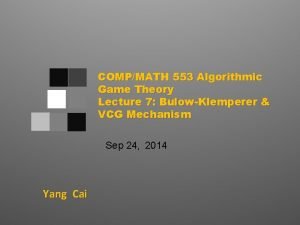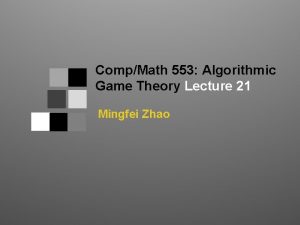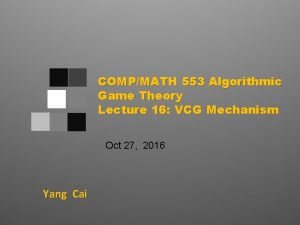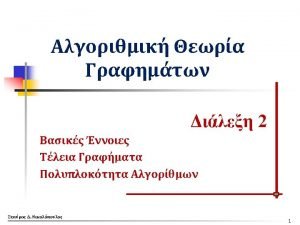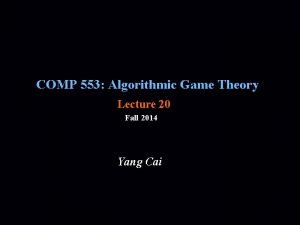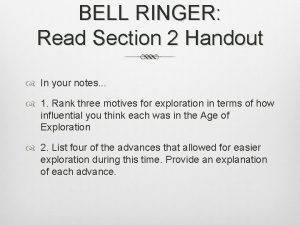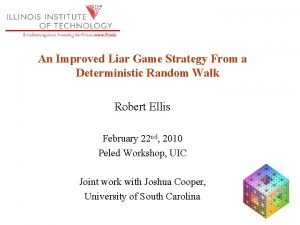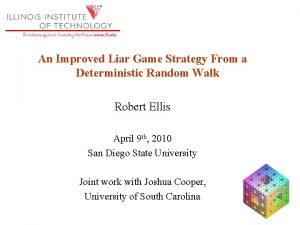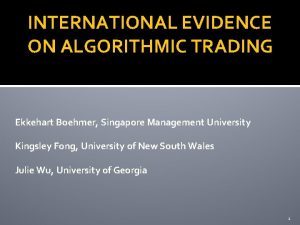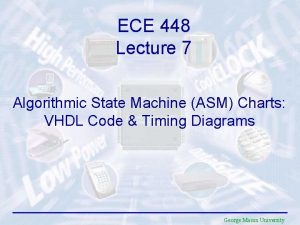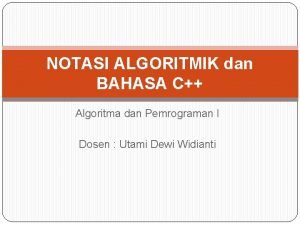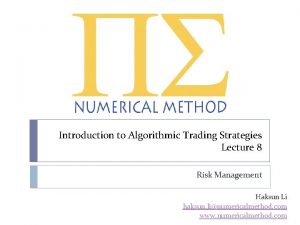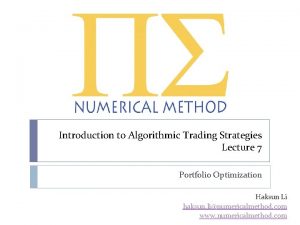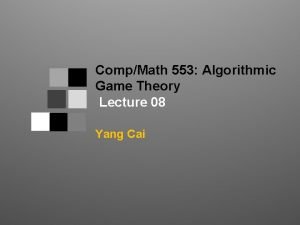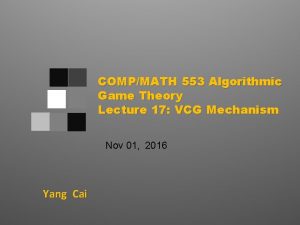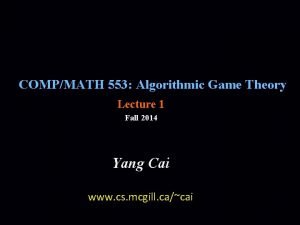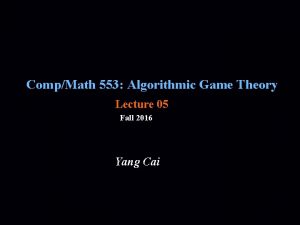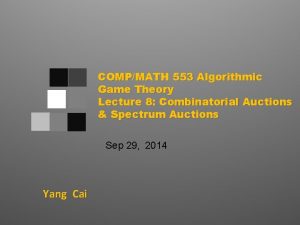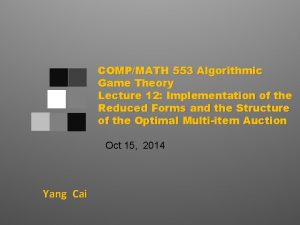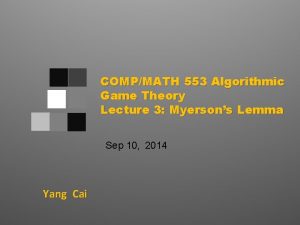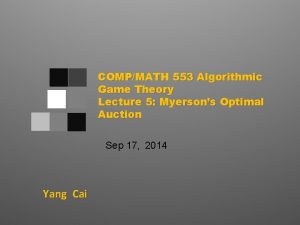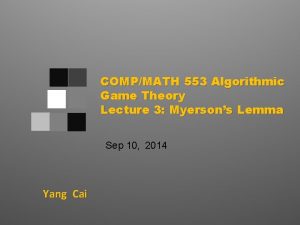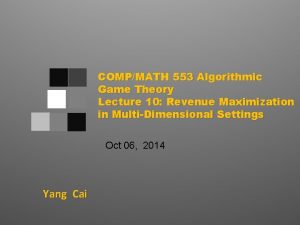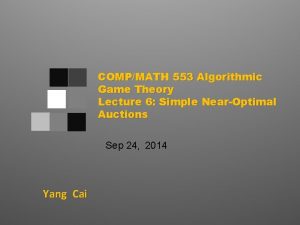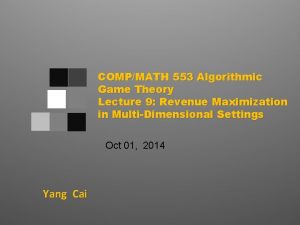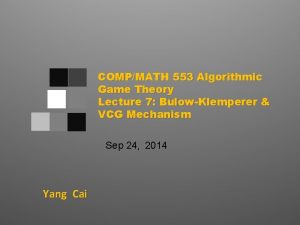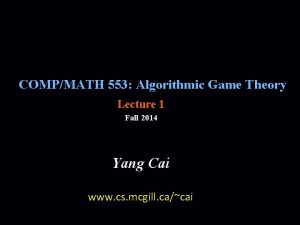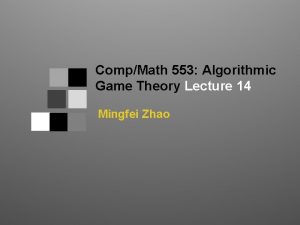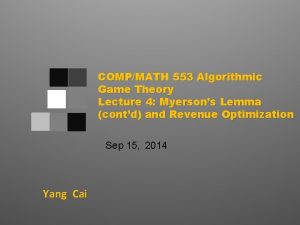CompMath 553 Algorithmic Game Theory Lecture 13 Yang


![Revenue-Optimal Auctions q [Myerson ’ 81 ] § Bayesian Single-dimensional settings. § Exists Revenue-Optimal Revenue-Optimal Auctions q [Myerson ’ 81 ] § Bayesian Single-dimensional settings. § Exists Revenue-Optimal](https://slidetodoc.com/presentation_image_h2/8ed14b08cf5489eae2b3fe1047fc3769/image-3.jpg)
![Revenue = Virtual Welfare [Myerson ’ 81] Fix a Bayesian single-dimensional environment, where bidder Revenue = Virtual Welfare [Myerson ’ 81] Fix a Bayesian single-dimensional environment, where bidder](https://slidetodoc.com/presentation_image_h2/8ed14b08cf5489eae2b3fe1047fc3769/image-4.jpg)

![One U[0, 1] Bidder, One Item q Recall that posting a price of ½ One U[0, 1] Bidder, One Item q Recall that posting a price of ½](https://slidetodoc.com/presentation_image_h2/8ed14b08cf5489eae2b3fe1047fc3769/image-6.jpg)
![Two U[0, 1] Bidders, One Item q Recall that Vickrey without reserve has expected Two U[0, 1] Bidders, One Item q Recall that Vickrey without reserve has expected](https://slidetodoc.com/presentation_image_h2/8ed14b08cf5489eae2b3fe1047fc3769/image-7.jpg)
![Two U[0, 1] Bidders, One Item (cont. ) q Recall that the virtual transform Two U[0, 1] Bidders, One Item (cont. ) q Recall that the virtual transform](https://slidetodoc.com/presentation_image_h2/8ed14b08cf5489eae2b3fe1047fc3769/image-8.jpg)




![Optimal Auction for Regular Distributions [Myerson ’ 81] Fix a Bayesian single-dimensional environment, where Optimal Auction for Regular Distributions [Myerson ’ 81] Fix a Bayesian single-dimensional environment, where](https://slidetodoc.com/presentation_image_h2/8ed14b08cf5489eae2b3fe1047fc3769/image-13.jpg)






![Prophet Inequality [Krengel-Sucheston-Garling ’ 79]: There exists a strategy guaranteeing: expected payoff ≥ 1/2 Prophet Inequality [Krengel-Sucheston-Garling ’ 79]: There exists a strategy guaranteeing: expected payoff ≥ 1/2](https://slidetodoc.com/presentation_image_h2/8ed14b08cf5489eae2b3fe1047fc3769/image-20.jpg)
- Slides: 20

Comp/Math 553: Algorithmic Game Theory Lecture 13 Yang Cai

Menu Recap: Virutal Welfare = Revenue Myerson’s Optimal Auction Prophet Inequalities
![RevenueOptimal Auctions q Myerson 81 Bayesian Singledimensional settings Exists RevenueOptimal Revenue-Optimal Auctions q [Myerson ’ 81 ] § Bayesian Single-dimensional settings. § Exists Revenue-Optimal](https://slidetodoc.com/presentation_image_h2/8ed14b08cf5489eae2b3fe1047fc3769/image-3.jpg)
Revenue-Optimal Auctions q [Myerson ’ 81 ] § Bayesian Single-dimensional settings. § Exists Revenue-Optimal auction that is “simple” direct DSIC Optimality: The expected revenue of Myerson’s auction when all bidders report truthfully (which is in their best interest to do since the auction is DSIC) is as large as the expected revenue of any other (potentially indirect) interim IR auction, when bidders use Bayesian Nash equilibrium strategies.
![Revenue Virtual Welfare Myerson 81 Fix a Bayesian singledimensional environment where bidder Revenue = Virtual Welfare [Myerson ’ 81] Fix a Bayesian single-dimensional environment, where bidder](https://slidetodoc.com/presentation_image_h2/8ed14b08cf5489eae2b3fe1047fc3769/image-4.jpg)
Revenue = Virtual Welfare [Myerson ’ 81] Fix a Bayesian single-dimensional environment, where bidder distributions are F 1, …, Fn, and F=F 1 x…x. Fn. Let also (x, p) be a BIC mechanism satisfying interim IR and NPT. The expected revenue of this mechanism under truth-telling is Ev~F[Σi pi(v)]=Ev~F[Σi xi(v) φi (vi)], where φi (vi) : = vi- (1 -Fi(vi))/fi(vi) is bidder i’s “virtual value function” (fi is the density function for Fi).

Example Applications
![One U0 1 Bidder One Item q Recall that posting a price of ½ One U[0, 1] Bidder, One Item q Recall that posting a price of ½](https://slidetodoc.com/presentation_image_h2/8ed14b08cf5489eae2b3fe1047fc3769/image-6.jpg)
One U[0, 1] Bidder, One Item q Recall that posting a price of ½ achieves expected revenue ¼. q Is ¼ the optimal expected revenue of any IR auction? q Answer: yes, it is! q Proof: q The virtual transform for U[0, 1] distribution is: q By Myerson’s theorem, any BIC, IR, NPT mechanism (x, p) has revenue. q Notice that for all possible x(): q Hence, posting a price of ½ is optimal as it achieves the best possible expected virtual welfare, and hence expected revenue.
![Two U0 1 Bidders One Item q Recall that Vickrey without reserve has expected Two U[0, 1] Bidders, One Item q Recall that Vickrey without reserve has expected](https://slidetodoc.com/presentation_image_h2/8ed14b08cf5489eae2b3fe1047fc3769/image-7.jpg)
Two U[0, 1] Bidders, One Item q Recall that Vickrey without reserve has expected revenue ⅓, while Vickrey with reserve ½ has expected revenue 5/12. q Is 5/12 the optimal expected revenue of any interim IR auction? q Answer: yes it is!
![Two U0 1 Bidders One Item cont q Recall that the virtual transform Two U[0, 1] Bidders, One Item (cont. ) q Recall that the virtual transform](https://slidetodoc.com/presentation_image_h2/8ed14b08cf5489eae2b3fe1047fc3769/image-8.jpg)
Two U[0, 1] Bidders, One Item (cont. ) q Recall that the virtual transform for v~U[0, 1] is: φ(v)= 2 v-1 q By Myerson’s theorem, Optimizing expected revenue = Optimizing expected virtual welfare subject to interim monotonicity (needed for BIC) q Let’s try to optimize virtual welfare point-wise on every bid profile (forgetting about interim monotonicity temporarily) q On bid profile (v 1, v 2), the pair of virtual values are (φ(v 1), φ(v 2))=(2 v 1 -1, 2 v 2 -1). How should we allocate? • If max{v 1, v 2} ≥ ½, let’s give the item to the bidder with highest value/virtual value. • Otherwise, φ(v 1), φ(v 2) < 0. So let’s not allocate the item. q Note that the above allocation rule is monotone, so by Myerson’s lemma there is a price rule that makes it DSIC. q DSIC + pointwise optimal virtual welfare => DSIC, Revenue-optimal q Now, notice that the above auction is identical to Vickrey auction with reserve ½ (which has revenue 5/12 and is actually DSIC).

Myerson’s Optimal Auction

Revenue-optimal Single-Dimensional Auction q By revelation principle, instead of optimizing over all (potentially indirect) interim IR auctions, can optimize over direct interim IR, BIC auctions. q In fact, can also assume interim NPT, as if interim NPT is not satisfied expected revenue can be increased by turning it interim NPT. q Hence, by Myerson’s theorem suffices to find the interim monotone allocation rule that optimizes expected virtual welfare. q Let’s ignore interim monotonicity temporarily. What allocation rule optimizes expected virtual welfare? q Answer: Optimize virtual welfare pointwise, i. e. on every bid profile v. i. e. on bid profile v solve: max Σi xi φi (vi), s. t x X q Call this allocation rule the Virtual Welfare-Maximizing Rule.

Revenue-optimal Single-Dimensional Auction q Pertinent Question: Is the Virtual Welfare-Maximizing Rule monotone? q If yes, done! And, in fact, with a DSIC mechanism q But answer depends on the distribution: • e. g. suppose one item is sold to one bidder whose value is ⅔U[0, 1] + ⅓ U[1, 3]; then virtual welfare-maximizing rule is not monotone q Distributions resulting in monotone allocation rules?

Regular Distributions
![Optimal Auction for Regular Distributions Myerson 81 Fix a Bayesian singledimensional environment where Optimal Auction for Regular Distributions [Myerson ’ 81] Fix a Bayesian single-dimensional environment, where](https://slidetodoc.com/presentation_image_h2/8ed14b08cf5489eae2b3fe1047fc3769/image-13.jpg)
Optimal Auction for Regular Distributions [Myerson ’ 81] Fix a Bayesian single-dimensional environment, where all bidders draw values from regular distributions. Then the auction whose allocation rule is the virtual welfare maximizing allocation rule (and whose price rule is uniquely determined by the allocation rule so that the resulting auction is interim IR, NPT) is DSIC and revenue-optimal (among all interim IR, potentially indirect auctions).

Discussion about Myerson’s Auction

How Simple is Myerson’s Auction? q Single-item setting, w/ regular i. i. d. bidders, i. e. F 1=F 2=. . . =Fn: • All φi ( )’s are the same and monotone. • the highest bidder has the highest virtual value • the optimal auction is the Vickrey auction with reserve price φ-1(0). q Killer application: e. Bay (assuming the starting prices are chosen well. . . )

How Simple is Myerson’s Auction? q Single-item setting, w/ regular independent bidders, but F 1≠F 2≠. . . ≠Fn q All φi ( )’s are monotone, but are not the same. q e. g. 2 bidders, v 1 uniform in [0, 1]. v 2 uniform in [0, 100]. - φ1(v 1) = 2 v 1 -1, φ2(v 2) = 2 v 2 -100 - Optimal Auction: • When v 1 > ½, v 2 < 50, allocate to 1 & charge ½. • When v 1 < ½, v 2 > 50, allocate to 2 & charge 50. • When 0 < 2 v 1 -1 < 2 v 2 – 100, allocate to 2 & charge: (99+2 v 1 )/2, a tiny bit above 50 • When 0 < 2 v 2 -100 < 2 v 1 -1, allocate to 1 & charge: (2 v 2 -99)/2, a tiny bit above ½.

How Simple is Myerson’s Auction? q In non-i. i. d. single-dimensional settings, Myerson’s auction is hard to explain to someone who hasn’t studied virtual valuations. q “Weirdness” of auction is inevitable if you are 100% confident in your model (i. e. , the Fi’s) and you want every last cent of the maximumpossible expected revenue. q Alternatives to Myerson’s Auction? q Are there simpler, more practical, and more robust auctions than theoretically optimal auction? q Optimality requires complexity, thus we’ll only look for approximately optimal solutions.

Prophet Inequalities

Optimal Stopping Rules q Consider the following game: • there are n stages • in stage i, you are offered a nonnegative prize πi, drawn from some distribution Gi • you are given the distributions G 1, . . . , Gn before the game begins, and told that the prizes are drawn independently from these distributions • but each πi is revealed at the beginning of stage i. • after seeing πi, you can either accept the prize and end the game, or discard the prize and proceed to the next stage. q Question: Is there a strategy for playing the game, whose expected reward competes with that of a prophet who knows all realized πi’s and picks the largest?
![Prophet Inequality KrengelSuchestonGarling 79 There exists a strategy guaranteeing expected payoff 12 Prophet Inequality [Krengel-Sucheston-Garling ’ 79]: There exists a strategy guaranteeing: expected payoff ≥ 1/2](https://slidetodoc.com/presentation_image_h2/8ed14b08cf5489eae2b3fe1047fc3769/image-20.jpg)
Prophet Inequality [Krengel-Sucheston-Garling ’ 79]: There exists a strategy guaranteeing: expected payoff ≥ 1/2 E[maxi πi]. In fact, a threshold strategy suffices. - Proof: On board; proof by Samuel-Cahn 1984. - Remark: Our lower-bound only credits ζ units of value when more than one prize is above ζ. This means that factor of ½ applies even if, whenever there are multiple prizes above threshold, the strategy picks the smallest one.
 Compmath
Compmath Compmath
Compmath Compmath
Compmath Algorithmic graph theory and perfect graphs
Algorithmic graph theory and perfect graphs Comp 553
Comp 553 Ece 553
Ece 553 Bcd addition of 184 and 576
Bcd addition of 184 and 576 Reread the primary source on page 553
Reread the primary source on page 553 01:640:244 lecture notes - lecture 15: plat, idah, farad
01:640:244 lecture notes - lecture 15: plat, idah, farad Abcde games
Abcde games Game lab game theory
Game lab game theory Liar game game theory
Liar game game theory Liar game game theory
Liar game game theory Algorithmic trading singapore
Algorithmic trading singapore Asm chart for mealy machine
Asm chart for mealy machine Abstraction computer science gcse
Abstraction computer science gcse Algorithmic nuggets in content delivery
Algorithmic nuggets in content delivery Algorithmic cost modelling
Algorithmic cost modelling Notasi
Notasi Introduction to algorithmic trading strategies
Introduction to algorithmic trading strategies Introduction to algorithmic trading strategies
Introduction to algorithmic trading strategies
